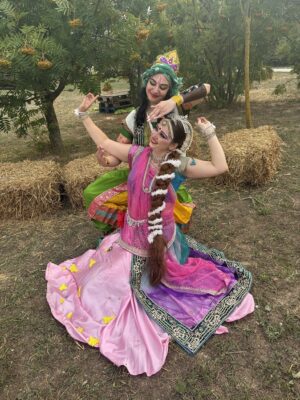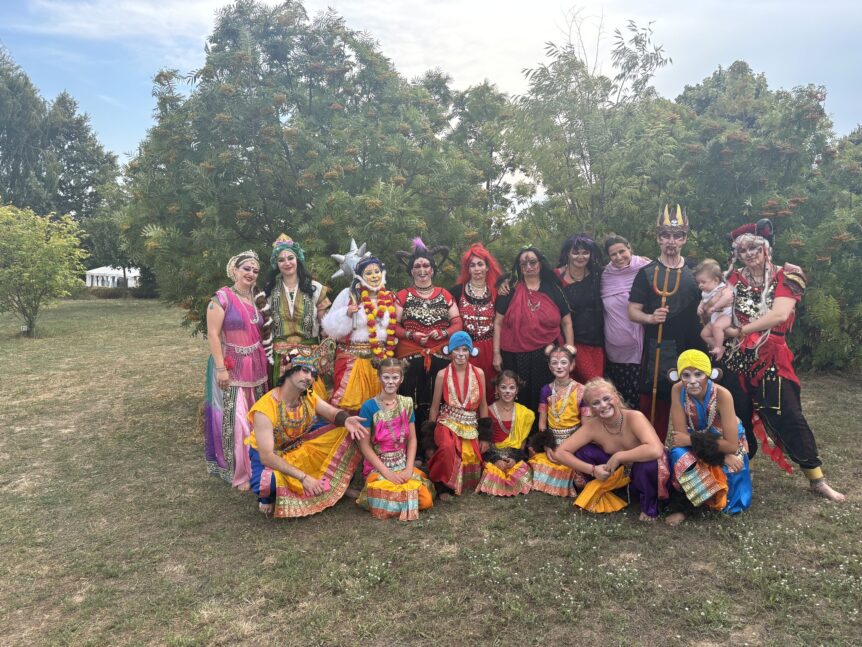Venue: Amrita Sher-Gil Kulturális Központ, 1025 Budapest, Búzavirág u. 14.
Date & time: 2024.10.30., 18.00 / 30.10.2024, 6 pm
Entry is free, but registration is required, please kindly fill up the form below: https://www.
The dance-drama Rāmāyaṇa is about a heroic deed of the Supreme Personality of Godhead, Kṛṣṇa, who came to earth in the form of a heroic archer, Rāma, in the Tretā age to deliver His devotees from the atrocities of demons and persons of demonic nature. Shortly after their marriage, Prince Rāma and his wife, Princess Sita, were banished to the jungle in the company of Rāma’s brother Lakṣmana. The jungle was also the hunting ground of the princess of the man-eating demons, who fell in love with the handsome archer Rāma. After the prince chased her away and rejected her, she ran to her brother Rāvaṇa for help. Rāvāna was not only filled with anger against Rāma, but also felt an unquenchable desire for the princess Sita, and resolved to kidnap her by deception, disguising his faithful sidekick as a deer. The demon succeeded, the princess could not be protected even by Lakṣmana’s magic circle. The demon had also defeated Prince Rāma’s vulture friend Jaṭāyu before abducting the princess to the island of Laṅkā. The devastated Rāma was eventually aided by Hanumān, the leader of the monkey armies, who sought out the kidnapped princess and built a bridge across the ocean with his army, using floating rocks on which the name Rāma was inscribed, traces of which can still be seen on satellite images of southeast India. Hanumana and Rāma’s army eventually triumphed over the demons and freed the ever-faithful princess from her captivity. They then returned home to their hometown Ayodhyā. The people loved and missed Sītā, Rāmā and his brother so much that they illuminated all their way to the Himālaya called ‘Dipavali’. Rāma’s victory as the triumph of light over darkness is still celebrated every year in India and around the world, just as a rock or two from the bridge of the monkey army still floats in the ocean waters.

According to experts on the ages of history, Rāma and his family lived on Earth two million years ago, and their teaching-filled story is told in the epics of Rāmāyaṇa and the Rāma-carita-mānasa.
The core performers of the Gauravani Dance Group are originally three sisters, Gītāvalī, Natesvarī and Nṛsiṁha-jīvanī, who have been dancing since childhood, and often make their own performing costumes, special make-up and props for their dance pieces. Originally, Gītāvalī started learning bhārata-natyam and then began teaching her younger sisters. Later, her sister Natesvarī also studied dance in India at the Venunad Kalakendra School, choosing the Odissi style. Later, in Hungary, they had the privilege of taking lessons from Dr. Neethu E. Mohan. The dancing sisters were later joined by young people from Budapest and Krishna Valley, and slowly became like a big family, meeting often and practicing for 5 hours every Sunday, in addition to their studies and vocation. The members of the dance troupe often take their audience to another world with their performances, where they can learn about Kṛṣṇa, the Supreme, and also about Indian culture. In addition to classical dance styles, they enchant their guests with modern dances and plays such as Rāmāyaṇa. The members of the group are all active members of the Kṛṣṇa conscious devotee community, and have been practicing spiritual life since their youth and are disciples of Śrīla Indradyumna Svāmī and Śrīla Śivarāma Svāmī.

